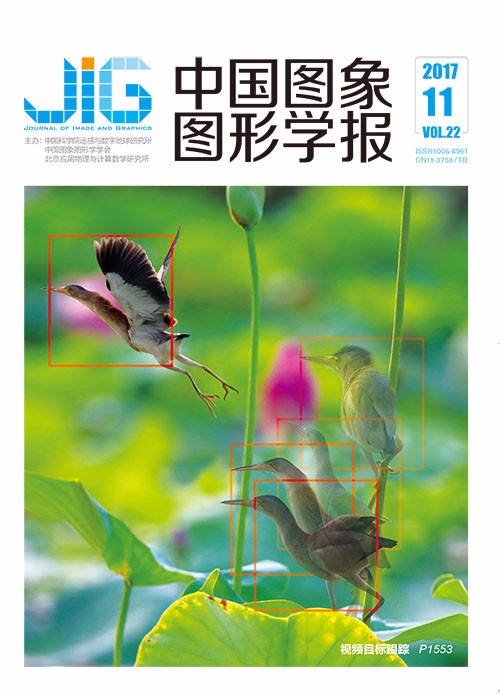
利用色调—亮度彩色分量的可见光植被指数
摘 要
目的 无人机遥感具有高时效、高分辨率、低成本、操作简单等优势。但由于无人机通常只携带可见光传感器,无法计算由可见光-近红外波段组合所构造的植被指数。为解决这一问题,提出一种归一化色调亮度植被指数NHLVI (normalized hue and lightness vegetation index)。方法 通过分析HSL (hue-saturation-lightness)彩色空间模型,构建一种基于色调亮度的植被指数,将该植被指数以及其他常用的可见光植被指数,如归一化绿红差值指数NGRDI (normalized green-red difference index)、过绿指数ExG (excess green)、超绿超红差分指数ExGR (excess green minus excess red)等,分别与野外实测光谱数据和无人机多光谱数据的NDVI (normalized difference vegetation index)进行相关性比较;利用受试者工作特征曲线ROC (receiver operating characteristic curve)的特点确定阈值,并进行植被信息提取与分析。结果 NHLVI与NDVI相关性高(R2=0.776 8),而其他可见光植被指数中,NGRDI与NDVI相关性较高(R2=0.687 4);ROC曲线下面积大小作为评价不同植被指数区分植被与非植被的指标,NHLVI指数在ROC曲线下面积为0.777,小于NDVI (0.815),但大于NGRDI (0.681),区分植被与非植被能力较强。为进一步验证其精度,利用阈值法提取植被,NHLVI提取植被信息的总体精度为82.25%,高于NGRDI (79.75%),尤其在植被稀疏区,NHLVI的提取结果优于NGRDI。结论 提出的归一化色调亮度植被指数,提取植被精度较高,适用于无人机可见光影像植被信息提取,为无人机可见光影像的应用提供了新方法。
关键词
Vegetation index for visible-light true-color image using hue and lightness color channels
Mao Zhihui, Deng Lei, He Ying, Hao Xianglei, Yan Yanan(College of Resource Environment and Tourism,Capital Normal University,Beijing 100048,China) Abstract
Objective An unmanned aerial vehicle (UAV) exhibits many advantages in remote sensing because of its high efficiency,high resolution,low cost,and simple operation.However,most UAVs carry only visible-light true-color sensors,which only contain red,green,and blue bands.Generating some of the most commonly used visible-near infrared-based vegetation indices,such as normalized difference vegetation index (NDVI) and soil-adjusted vegetation index,is difficult.Although hyperspectral and multispectral sensors can produce the previously mentioned indices,the high cost and complexity of data acquisition hinder the further development of UAV technology in the field of vegetation remote sensing.A new vegetation index,which can fully utilize visible-light true-color image in the HSL color space,called Normalized Hue and Lightness Vegetation Index (NHLVI),has been proposed to solve this problem.Method The characteristics of hue and lightness of different objects in the HSL color space model were analyzed within visible-light true-color image,and the hue (H) and lightness (L) components were selected because of their weak correlations.After their normalization,NHLVI was constructed on the basis of the form of NDVI to enhance the vegetation information.A total of 88 visible true-color and 163 multispectral images,which covered a test area with different vegetation types and coverage,were acquired through a UAV flight campaign to verify the validity of this new vegetation index.The structure from motion algorithm was used to mosaic the UAV images,and the digital orthophoto map of the test area was produced.Then,the NHLVI and several commonly used visible vegetation indices,i.e.,normalized green-red difference index (NGRDI),excess green,vegetation index,color index of vegetation,excess green minus excess red,combination,and combination 2,were calculated.Hyperspectral datasets were simultaneously collected using the ASD HandHeld2 during the UAV flight and were resampled to match visible true-color and multispectral sensors in accordance with their spectral response function.For the multispectral image,the digital number value was converted to reflectance through the empirical line method.All the vegetation indices calculated from visible true-color UAV imagery were compared with NDVIs generated from ASD and UAV multispectral data.The receiver operating characteristic (ROC) curve was employed to analyze and determine the threshold to extract and compare vegetation information further.The results from different vegetation indices were compared.Result The correlation coefficient (R2) was used to evaluate the performance of all the vegetation indices from visible-light true-color imagery.The correlation coefficient(s) between different visible true-color-based vegetation indices and ASD-based and/or multispectral UAV-based NDVIs show that a high correlation exists between the proposed vegetation index and NDVI,with a correlation coefficient (R2) of 0.776 8,followed by the correlation between NGRDI and NDVI (R2=0.687 4).The ROC curve was utilized to explore the capability of the proposed vegetation index to extract vegetation information.NGRDI and NDVI were selected and compared with NHLVI.First,the area under the ROC curve was calculated for NHLVI (0.777),and it is smaller than that for NDVI (0.815) but larger than that for NGRDI (0.681).This finding indicates that NHLVI outperforms NGRDI in terms of vegetation extraction.Second,vegetation information was extracted by the predefined threshold and compared between different vegetation indices through visual interpretation.Given the difficulties in threshold determination,the ROC curve method was selected to decide the threshold.By selecting the point on the cutoff between the curve and a line with slope equals to 1,the sensitivity and specificity were maximized whereas the omission and commission errors were minimized.Finally,quantitative analysis was performed,400 random points were positioned on the UAV visible-light true-color image to derive the NHLVI,and the NDVI was extracted from the multispectral UAV image as a reference to evaluate the vegetation extraction accuracy.The overall vegetation extraction accuracy using NHLVI is 82.25%,which is higher than that of NGRDI (79.75%) and lower than that of NDVI (84.00%).The commission error of NHLVI is 6.64%,and the omission error is 22.82%.Notably,the proposed vegetation index,compared with the other vegetation indices,e.g.,NGRDI,performs outstandingly in sparsely vegetated areas.Conclusion The NHLVI was proposed in this study.This index takes advantage of the HSL color space transformation and makes good use of high spatial resolution visible-light true-color images,e.g.,UAV images.Experimental results show that the proposed vegetation index,compared with several commonly used vegetation indices,possesses a stronger correlation with NDVI and exhibits the same value range,i.e.,[-1,1].Vegetation cover information can be extracted using the threshold set by the ROC method.The proposed method can achieve outstanding results compared with other vegetation indices,particularly in sparsely vegetated areas,and presents nearly the same accuracy as NDVI.Overall,NHLVI is suitable for vegetation extraction from visible-light true-color images from UAVs and provides a new method for the application of UAV-based remote sensing.Future works will focus on its application to different types of vegetation and verification in different sensors.
Keywords
hue-saturation-lightness (HSL) transform vegetation index unmanned aerial vehicle (UAV) visible-light vegetation extraction
|



 中国图象图形学报 │ 京ICP备05080539号-4 │ 本系统由
中国图象图形学报 │ 京ICP备05080539号-4 │ 本系统由